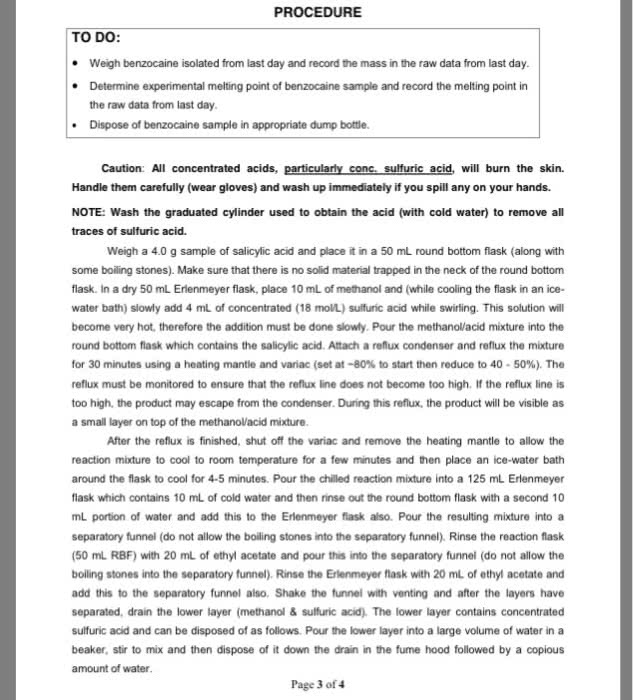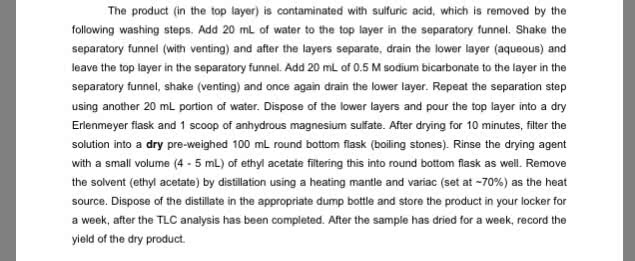I need help creating a separation scheme and procedure for a lab. We have two days to do the lab. The first day is to see whatâs wrong with our procedure, the second day to fix it and achieve better results.
I will put the problems/observations and questions from the first attempt in brackets and italics.
Separate and purify all three compounds. Mixture contains m-toluic acid, ethyl-3-aminobenzoate, and 1,4 dibromobenzene.
1. Separating m-toluic acid from Ethyl 3-aminobenzoate and 1,4 dibromobenzene
Dissolve 0.15g of mixture in methylene chloride in a separatory funnel. Add 1M NaOH and shake the funnel, venting periodically. Drain out bottom organic layer containing Ethyl 3-aminobenzoate and 1,4 dibromobenzene into flask. Pour out aqueous layer containing m-tuloic acid into separate flask.
2. Separating Ethyl 3-aminobenzoate and 1,4 dibromobenzene
Add 6M HCl dropwise to the organic layer until it is acidic. [A very thick precipitate formed and it did not separate in to two layers. Is this precipitate the result of the H2N from the Ethyl 3-aminobenzoate reacting with the HCl, forming NH3+ and Cl-? Or the NaOH forming NaCl?] Add methylene chloride (so precipitate isnât so thick) and water and shake. Separate the two layers into separate containers.
3. Purifying 1,4 dibromobenzene
With the organic layer from step 2 filter out the precipitate [why did the precipitate stay in the organic layer?]. To the liquid add anhydrous sulfate, transfer the remaining liquid to a pre-weighed flask or beaker, and evaporate it. Check the melting point to determine purity.
4. Purifying Ethyl 3-aminobenzoate
To the aqueous layer from step 2, add NaOH until itâs basic. [Iâm not sure what to do after this]
5. Purifying m-toluic acid
To the aqueous layer from step 1 add HCl dropwise until itâs acidic. [formed precipitate] Add methylene chloride. Separate the organic and aqueous layers. To the organic layer containing m-toluic acid and water, add anhydrous sulfate. Remove the remaining liquid into separate pre-weighed flask and evaporate. Take melting point of dry product to determine purity.
I need help creating a separation scheme and procedure for a lab. We have two days to do the lab. The first day is to see whatâs wrong with our procedure, the second day to fix it and achieve better results.
I will put the problems/observations and questions from the first attempt in brackets and italics.
Separate and purify all three compounds. Mixture contains m-toluic acid, ethyl-3-aminobenzoate, and 1,4 dibromobenzene.
1. Separating m-toluic acid from Ethyl 3-aminobenzoate and 1,4 dibromobenzene
Dissolve 0.15g of mixture in methylene chloride in a separatory funnel. Add 1M NaOH and shake the funnel, venting periodically. Drain out bottom organic layer containing Ethyl 3-aminobenzoate and 1,4 dibromobenzene into flask. Pour out aqueous layer containing m-tuloic acid into separate flask.
2. Separating Ethyl 3-aminobenzoate and 1,4 dibromobenzene
Add 6M HCl dropwise to the organic layer until it is acidic. [A very thick precipitate formed and it did not separate in to two layers. Is this precipitate the result of the H2N from the Ethyl 3-aminobenzoate reacting with the HCl, forming NH3+ and Cl-? Or the NaOH forming NaCl?] Add methylene chloride (so precipitate isnât so thick) and water and shake. Separate the two layers into separate containers.
3. Purifying 1,4 dibromobenzene
With the organic layer from step 2 filter out the precipitate [why did the precipitate stay in the organic layer?]. To the liquid add anhydrous sulfate, transfer the remaining liquid to a pre-weighed flask or beaker, and evaporate it. Check the melting point to determine purity.
4. Purifying Ethyl 3-aminobenzoate
To the aqueous layer from step 2, add NaOH until itâs basic. [Iâm not sure what to do after this]
5. Purifying m-toluic acid
To the aqueous layer from step 1 add HCl dropwise until itâs acidic. [formed precipitate] Add methylene chloride. Separate the organic and aqueous layers. To the organic layer containing m-toluic acid and water, add anhydrous sulfate. Remove the remaining liquid into separate pre-weighed flask and evaporate. Take melting point of dry product to determine purity.




